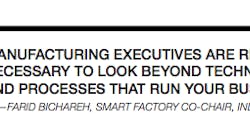Many of us in the manufacturing space are quick to herald the ubiquity of digital transformation. “It’s changing everyone! And everything! And every way we do every process!”
And that’s true. Or it’s growing truer every day as headlines tout new, smart approaches to everything from fabricating to farming to fire-fighting. But within that universality there are differences, of course. There are different applications. Different motivations. Different success rates.
In the industrial space, a major differentiator is whether you’re talking about discrete or process manufacturing.
So, what’s the difference? What’s the divide between discrete manufacturing (the production of distinct, finished products such as automobiles) and process manufacturing (the production of goods by combining substances using a formula or recipe, such as gasoline) when it comes to digital transformation?Some things aren’t that different. As Todd Mason-Darnell, marketing manager for automation supplier Omron, explains, “Gathering data is not difficult. Manufacturers can start adding various sensors to their equipment and start collecting data. The problem is to gather useful data.” By useful data he means data that is germane to potential problems, data that is understandable enough to enable action, and delivered quickly enough to affect change during a sub-optimal operation—while that automobile chassis is on the production line or that batch of beer is still in the fermenter.
But the machine-centric nature of discrete manufacturing lends itself to a certain type of advanced data analytics. “With the recognition that discrete manufacturing is primarily made of purpose-built machines, there is a lot of opportunity to utilize machine-generated data to make data-driven decisions completely within the machine itself,” says Mike Chen, director of Omron’s Automation Center for the Americas.
Simultaneously, there are practical reasons discrete manufacturers are increasingly turning toward digital manufacturing. Those bound to government compliance, for example, are attracted by the ease of parts traceability allowed by digital workflows.
Discrete manufacturing often requires more labor relative to output, adds Anthony DeLima, CTO at digital consultancy NEORIS, who notes that in process manufacturing production runs are usually made in large batches of a consistent product, with a smaller number of inputs. On the flip side in discrete environments, every finished assembly can be unique and, oftentimes, requires larger number of inputs that may be specific to that particular assembly. This explains the complexity in controlling KPIs and the extended response time for changes. “The priority on where the most value would be generated is different than in process manufacturing,” he says.
And, naturally, motivation comes into play.
“Discrete manufacturers are drawn by the broader benefits of the digital approach—easy solutions that don’t require the skill level of a data scientist,” says Jonathan Griffith, product manager for AutomationDirect. “They want an easy-to-use solution that doesn’t require them being an IT expert or learning a new technology. And, they also want built-in security so they can implement the solution within their environment.”
Tech tools at work
So, let’s talk tools…the arrows within the Industry 4.0 quiver. Does tool adoption differ between discrete and process manufacturers?
Farid Bichareh, Smart Factory co-chair with the Industrial Internet Consortium, notes that discrete manufacturers are readily adopting the basic elements of the smart factory on their path toward digital transformation—“the simple automation concepts such as robotics, control systems, manufacturing cells, MES, etc.”
Griffith recognizes a shift by discrete manufacturers to embrace Industry 4.0 technologies, lured by improved productivity of semi-automated operations at play in the discrete space and bolstered cybersecurity with modern devices.
But collecting these fabulous new tools and toys isn’t always easy. “One issue is the price of smart manufacturing products,” explains Karla Trotman, COO of electronics manufacturer Electro Soft Inc. and member of the 2019 class of Influential Women in Manufacturing. “They require a huge capital investment and the payoff period can be hard to predict in a custom environment.”
If cost weren’t an issue, there are plenty of items on the wish list. Chen lists the growing number of devices capable of broadcasting useful data from machines, all of which are now capable of creating valuable insights for discrete manufacturers—power supplies, smart sensors, condition monitors, servos, even robots. “Each product can be applied to change production operation modes based on that insight, optimizing overall productivity,” he says, adding that as requirements for full production traceability have grown in the discrete space (where individual components must be tracked through final product), vision/sensing/marking technologies and products have increased in demand.
Digitalization challenges
The digitalization challenges faced by discrete manufacturers will sound familiar to any business leader in any industrial field—cost, lack of understanding, overly complex processes, security lapses, inefficiencies that can’t be uncovered, personnel that can’t or won’t get on board with this whole Industry 4.0 thing.Trotman notes that, as a custom manufacturer of electronics, she has to break down the manufacturing setup for each assembly. “We have been able to get the procedures down to a science where we can employ many of the same techniques. Machine programming, however, will always take time.”
The IIC’s Bichareh calls out three points of particular pain for the discrete folks:
Retrofitting legacy assets. “As OT and IT systems become more tightly integrated, OT will become the limiting factor for productivity and capability improvements due to the inability for hardware to evolve at the rate of software.”
Accommodating rapid data growth. “A smart factory requires collecting, analyzing, transporting, and storing vast amounts of data. The data must be filtered and processed to extract meaning and value, either at the edge or in the cloud. New systems are required to handle the challenges posed by the volume, velocity and variety of these data sets.” Protecting sensitive assets and systems from cyber-attacks. “IT security is every bit as problematic an issue in the smart factory as in IIoT initiatives at large. Industrial networks, which were originally designed to be isolated, are now exposed to continuous attacks of ever-increasing sophistication. Additionally, with the proliferation of connected devices worldwide, there is a need to protect against not only malicious intent but also errors and mischance.”
Another challenge unique to the discrete arena: the dynamic between the end-user & the OEM/system integrator. The “smart” approach to manufacturing is dependent on the expertise of the end-user and the programming/integration from the machine supplier. This relationship isn’t always smooth. “The expectations in functionality vs. cost do not always match for both parties, which leads to slower adoption and more skepticism,” says Omron’s Chen, who finds that his customers making the greatest strides with data-driven innovation have the smoothest partnerships among teams responsible for production, machine-design and business metrics.
Finally, while we’re talking relationships, we must discuss people—specifically a lack of the right people—which continues to bedevil discrete manufacturers and hinder progress in the smart space. The widening skills gap is limiting adoption of digital processes on the discrete side, just as it is everywhere else. Says Chen, “The growing skills gap in manufacturing is preventing some companies from fully leveraging the technology available.” Adds Bichareh, “Manufacturing executives are realizing that it is necessary to look beyond technology at the people and processes that run your business.”
The opportunities at hand
OK. So we explored the challenges. Now let’s get optimistic with an exploration of the rewards awaiting discrete manufacturers who head down the digital path.
Driving adoption in the discrete space is newfound capability to meet the modern customer’s demand for customized products. They want it personalized, perfect and placed on their doorstep tomorrow. Previously unthinkable levels of customization are becoming the norm, which is a win for manufacturers who can produce lot sizes of one.
Similarly, manufacturing-as-a-service is nudging discrete manufacturers across the digital divide to enable shorter innovation cycles and quicker time-to-market.“As a discrete manufacturer, digital transformation has allowed us to streamline our work flow from receipt of order to shipment,” says Trotman, who notes other digitalization benefits including enhanced traceability and a speedier identification of redundancies and inefficiencies that enables better utilization of resources.
Along with these efficiencies, her team is investigating the value of cobots to provide assemblers a “third arm” while manufacturing complex assemblies. Trotman also notes an ancillary benefit of Industry 4.0—increased collaboration among competitors. “Rather than competing with our peers, we have looked to one another to solve our talent-pipeline issues,” she says. “Technology road-mapping has become an important new tool to solve our people issue. It allows us to see the best direction in which to invest. Those of us who are embracing Industry 4.0 now are willing to work together to identify ways to grow and not get left behind as our industry evolves.”
Digitalization done differently
Is the discrete side adopting digitalization elements as eagerly as their process counterparts?
There is great variance within both camps, naturally. There are discrete manufacturers doing brilliant things with data and others ignoring the whole digitalization trend in the hopes that they can retire before facing repercussions from their willful ignorance. Likewise, some in the process camp have jumped aboard the digital train while their peers cling to practices that grow dustier by the day. There are great reasons for early adoption; there are valid rationales for reticence.
With separation between end-user and OEM/ system-integrator, the expertise and incentive structure are sometimes more at odds in the discrete manufacturing space than on the process side, says Chen, who believes that the process industry has become much more of a complete engineering-ownership model (or a fully outsourced service model). “In either case, the experts are employed by the company with the most incentive for innovation.”
Just as their procedures and inputs differ, so too does digitalization look differently on either side of the divide. “The differences between discrete manufacturing and process or repetitive manufacturing mostly come from the perspective of challenges and priorities,” says Bichareh, citing how the hurdles and motivations of each define how they will implement smart-factory solutions.
Whether you’re making a thing—an automobile— or you’re processing a substance—gasoline—the gains presented by digital transformation grow more obvious by the day. Recall that whole everyone, everything, every way mindset.
Like their peers on the process side, discrete manufacturers are drawn by the broader benefits of the digital approach—actionable insights that inform smart strategic shifts. “Discrete manufacturers who have been successful are able to isolate business challenges that can be solved by leveraging both their people and the technology, and clearly showing their staff how both are beneficial to the workers and the company and the industry,” says Chen.
It makes perfect sense, but it’s far from a quick fix.
The rewards for the discrete side might be greater. The adoption of Industry 4.0 might be trickier. Getting to that point of true, comprehensive digital transformation for discrete manufacturers will be—for lack of a better term—a process.
Chris McNamara is content director with Smart Industry.







